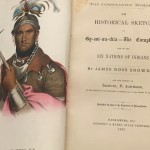People living on the Pennsylvania frontier often felt isolated and fearful. Scotch-Irish and German settlers, excluded from the best farmlands near Philadelphia, worked hard to clear lands and establish new farms and towns west of the Susquehanna. Although some of Pennsylvania’s original inhabitants, the Lenni-Lenape or Delaware Indians also found life difficult. They were dominated by the powerful Iroquois tribes to the north and cheated out of their land by white speculators. So, whether European immigrants or Native Americans, frontier folk seldom felt secure. In fact, they struggled to survive—to protect and support their families—in the freedom and chaos of the Pennsylvania frontier.
Stop by the Main Reading Room of the State Library and see rare books, maps and illustrations about Pennsylvania’s 18th century frontier. Examine portraits of the mighty Iroquois warrior Joseph Brant, Captain of the Six Nations, who fought for the British in the American Revolution, and the Delaware Chief Tishcohan, who signed the disastrous Walking Purchase of 1737. Read bloodcurdling accounts of kidnappings and massacres from Archibald Loudon’s 1811 Selection of Some of the Most Interesting Narratives of Outrages Committed in the French and Indian War. Follow Moravian missionary John Heckewelder and explorer John Bartram, as they lived and moved among the Delaware, Shawnee and Iroquois Indians. See an original 18th century map of Pennsylvania, as well as contemporary depictions of frontier forts and Indian settlements.
 A small volume tucked in the corner of the Frontier Exhibit might be easily overlooked. It is titled simply: The Cornplanter Memorial, which celebrates the dedication of a monument to the renowned Chief of the Seneca Nation. In a brief historical sketch Pennsylvania legislator James Ross Snowden relates a story about a weary traveler lost on the shores of Lake Chautauqua shortly after the American Revolution. He was welcomed into a warm Indian wigwam and fed a hearty meal of corn and venison. Unbeknown to him, his host was Cornplanter, the Seneca Chief. In the morning, after a good night’s sleep, the traveler was invited to sit on a log beside his host. After a moment the Indian asked him to move over a little. A short time later he asked his guest to move again. Finally, after several moves, the visitor protested that if he moved any farther, he would likely fall off the log! “That is the way you white people treat us,” said the Chief. Pointing out that General Washington, in a hurry to make peace with the British, had forgotten “his red brethren,” the Indian asked his guest, “Where are we to go?” The traveler sat quietly, unable to answer.
A small volume tucked in the corner of the Frontier Exhibit might be easily overlooked. It is titled simply: The Cornplanter Memorial, which celebrates the dedication of a monument to the renowned Chief of the Seneca Nation. In a brief historical sketch Pennsylvania legislator James Ross Snowden relates a story about a weary traveler lost on the shores of Lake Chautauqua shortly after the American Revolution. He was welcomed into a warm Indian wigwam and fed a hearty meal of corn and venison. Unbeknown to him, his host was Cornplanter, the Seneca Chief. In the morning, after a good night’s sleep, the traveler was invited to sit on a log beside his host. After a moment the Indian asked him to move over a little. A short time later he asked his guest to move again. Finally, after several moves, the visitor protested that if he moved any farther, he would likely fall off the log! “That is the way you white people treat us,” said the Chief. Pointing out that General Washington, in a hurry to make peace with the British, had forgotten “his red brethren,” the Indian asked his guest, “Where are we to go?” The traveler sat quietly, unable to answer.
Although a proponent of Iroquois neutrality, Cornplanter had followed the Chiefs of the Six Nations in fighting for King George III in the American Revolution. After the War, Cornplanter became a friend of the new United States and an advocate for peace. He served as a negotiator in the Second Treaty of Fort Stanwix (1784) that kept the Seneca out of the Northwestern Indian War. In 1790 he traveled to Philadelphia, where he met President George Washington and Pennsylvania Governor Thomas Mifflin to protest the treatment of his people and to ask for protection of Iroquois lands. Although Cornplanter later became disillusioned about his relationship with the United States, he supported her in the War of 1812, and always kept close ties to the Quakers, whose beliefs and practices impressed him. When he died in 1836, Cornplanter was over one hundred years of age.
The Pennsylvania Frontier exhibit will be on display in the State Library’s Main Reading Room from December 7, 2015 until March, 2016. You can stop by Tuesday-Thursday, 9:30 am to 5:00 pm or the second Saturday of the month from 9:30 am to 4:30 pm. Afterward, checkout a book from our collection about this fascinating period of Pennsylvania history.


